Introduction to Our Software Project
Overview
Teaching: 20 min
Exercises: 10 minQuestions
What is the design architecture of our example software project?
Why is splitting code into smaller functional units (modules) good when designing software?
Objectives
Use Git to obtain a working copy of our software project from GitHub.
Inspect the structure and architecture of our software project.
Understand Model-View-Controller (MVC) architecture in software design and its use in our project.
Patient Inflammation Study Project
So, you have joined a software development team that has been working on the patient inflammation study project developed in Python and stored on GitHub. The project analyses the data to study the effect of a new treatment for arthritis by analysing the inflammation levels in patients who have been given this treatment. It reuses the inflammation datasets from the Software Carpentry Python novice lesson.
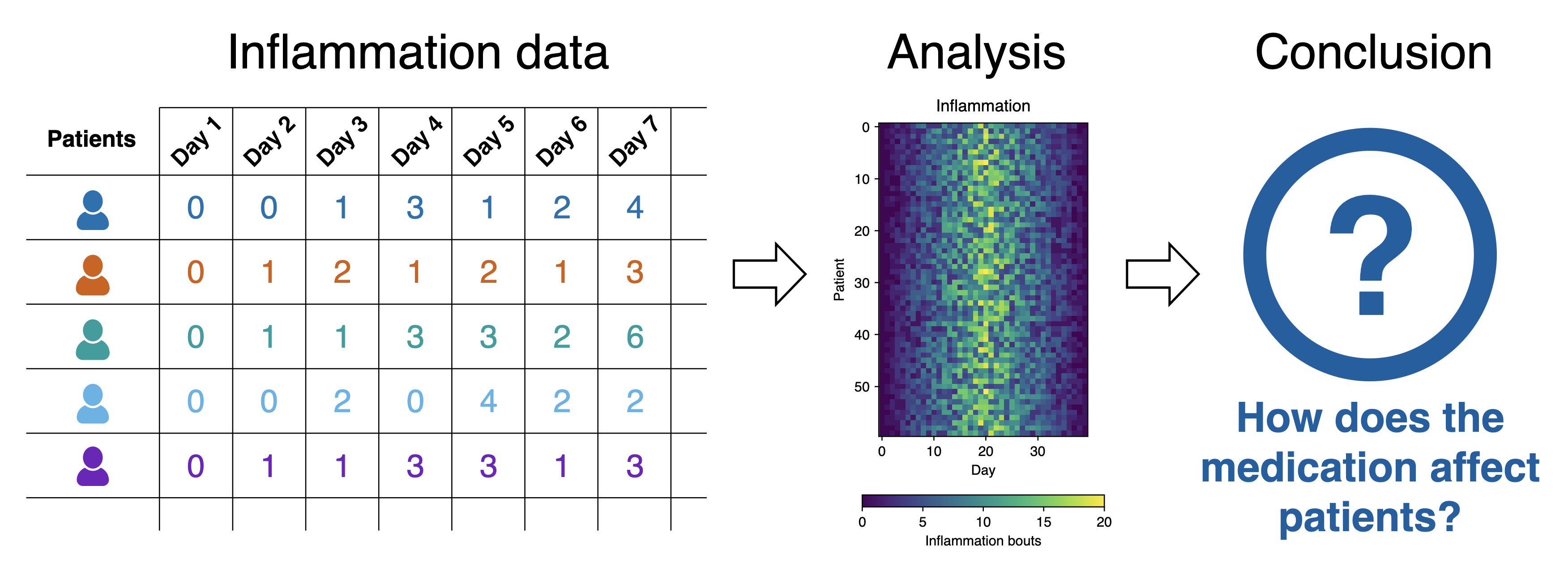
Inflammation study pipeline from the Software Carpentry Python novice lesson
What Does Patient Inflammation Data Contain?
Each dataset records inflammation measurements from a separate clinical trial of the drug, and each dataset contains information for 60 patients, who had their inflammation levels recorded for 40 days whilst participating in the trial (a snapshot of one of the data files is shown in diagram above).
Each of the data files uses the popular comma-separated (CSV) format to represent the data, where:
- Each row holds inflammation measurements for a single patient,
- Each column represents a successive day in the trial,
- Each cell represents an inflammation reading on a given day for a patient (in some arbitrary units of inflammation measurement).
The project is not finished and contains some errors. You will be working on your own and in collaboration with others to fix and build on top of the existing code during the course.
Downloading Our Software Project
To start working on the project, you will first create a copy of the software project template repository from GitHub within your own GitHub account and then obtain a local copy of that project (from your GitHub) on your machine.
- Make sure you have a GitHub account and that you have created a personal access token with GitHub, as explained in Setup.
- Log into your GitHub account.
- Go to the software project template repository in GitHub.
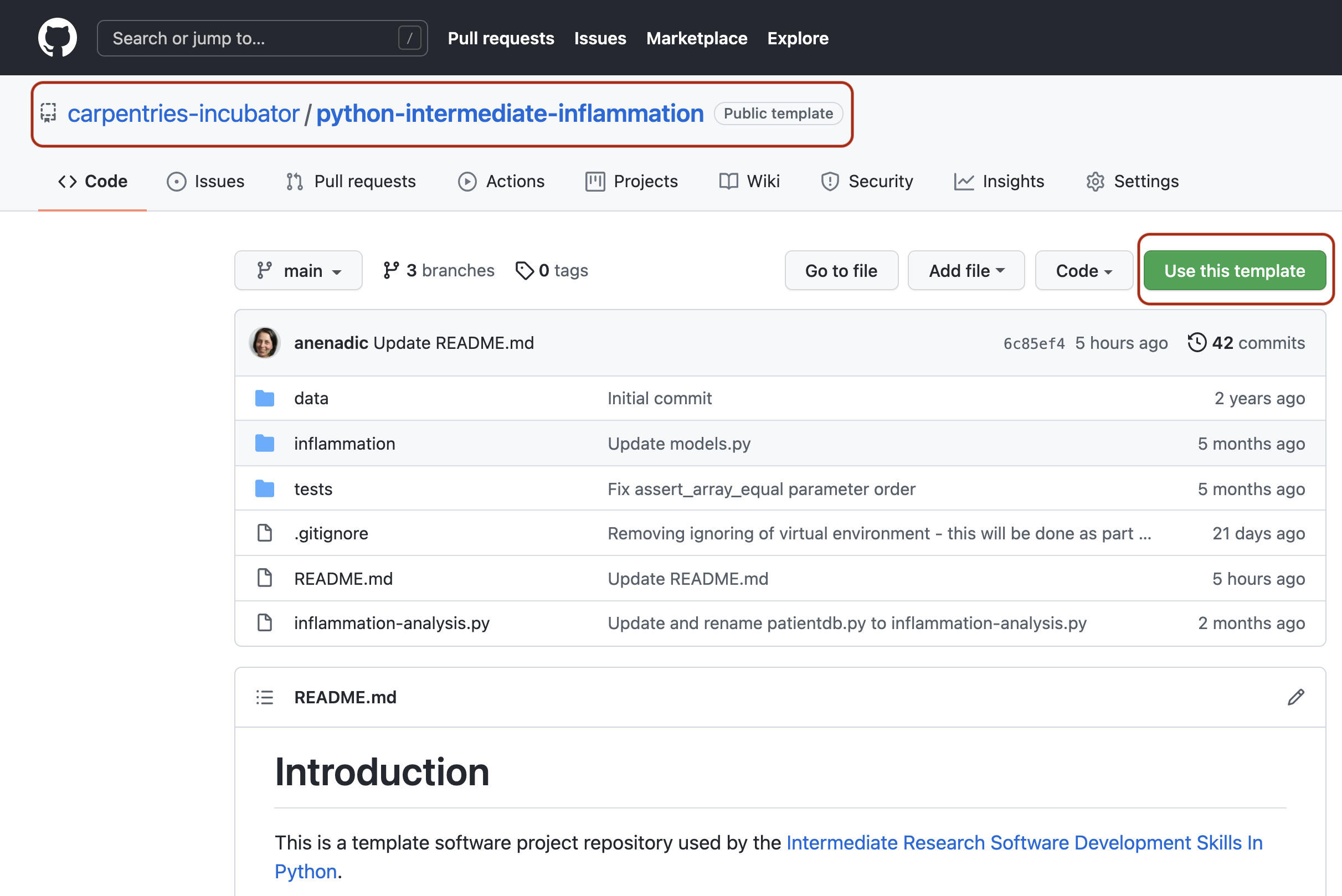
- Click the
Use this templatebutton towards the top right of the template repository’s GitHub page to create a copy of the repository under your GitHub account (you will need to be signed into GitHub to see theUse this templatebutton). Note that each participant is creating their own copy to work on. Also, we are not forking the directory but creating a copy (remember - you can have only one fork but can have multiple copies of a repository in GitHub). - Make sure to select your personal account and set the name of the project to
python-intermediate-inflammation(you can call it anything you like, but it may be easier for future group exercises if everyone uses the same name). Also set the new repository’s visibility to ‘Public’ - so it can be seen by others and by third-party Continuous Integration (CI) services (to be covered later on in the course).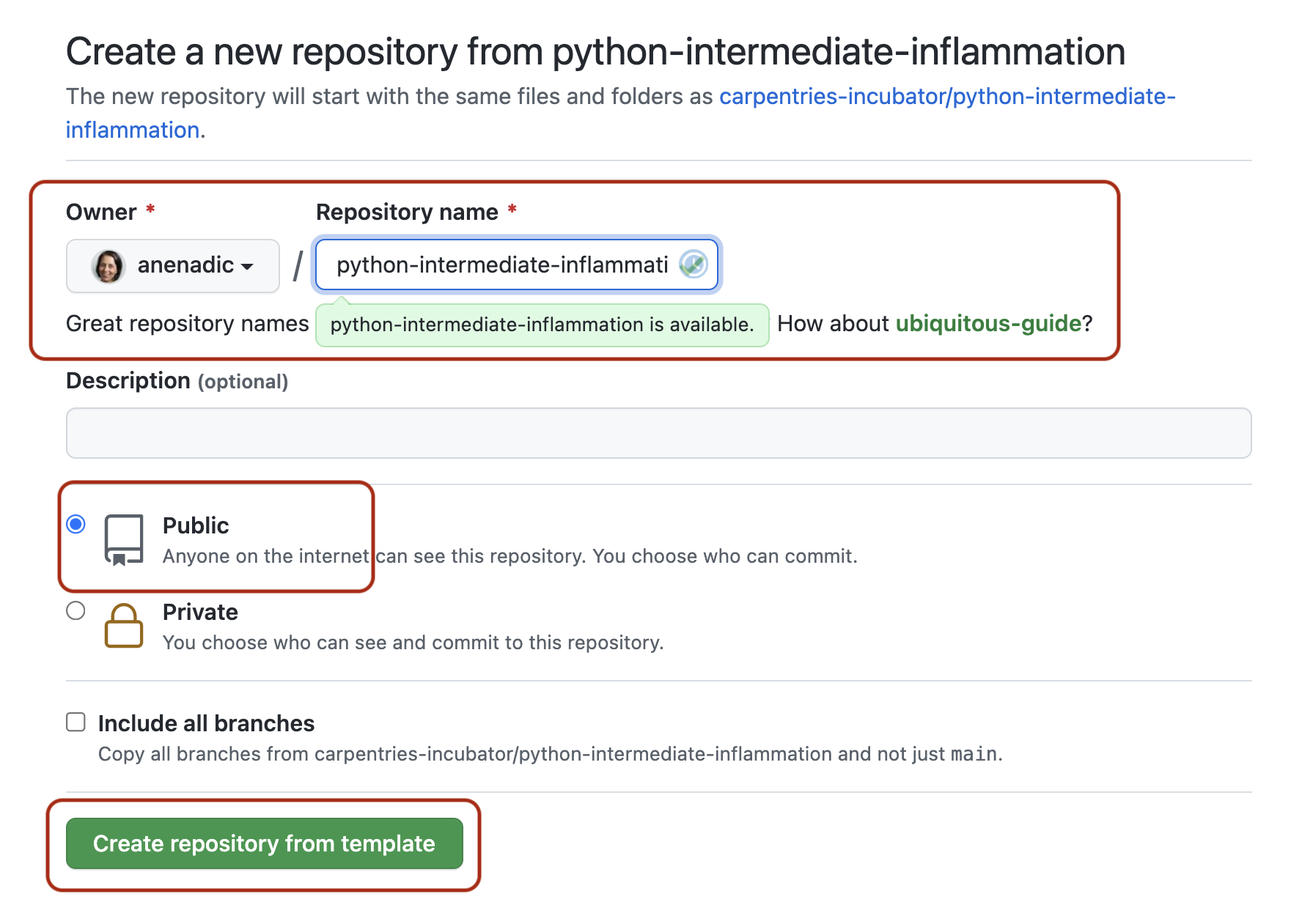
- Click the
Create repository from templatebutton and wait for GitHub to import the copy of the repository under your account. - Locate the copied repository under your own GitHub account.
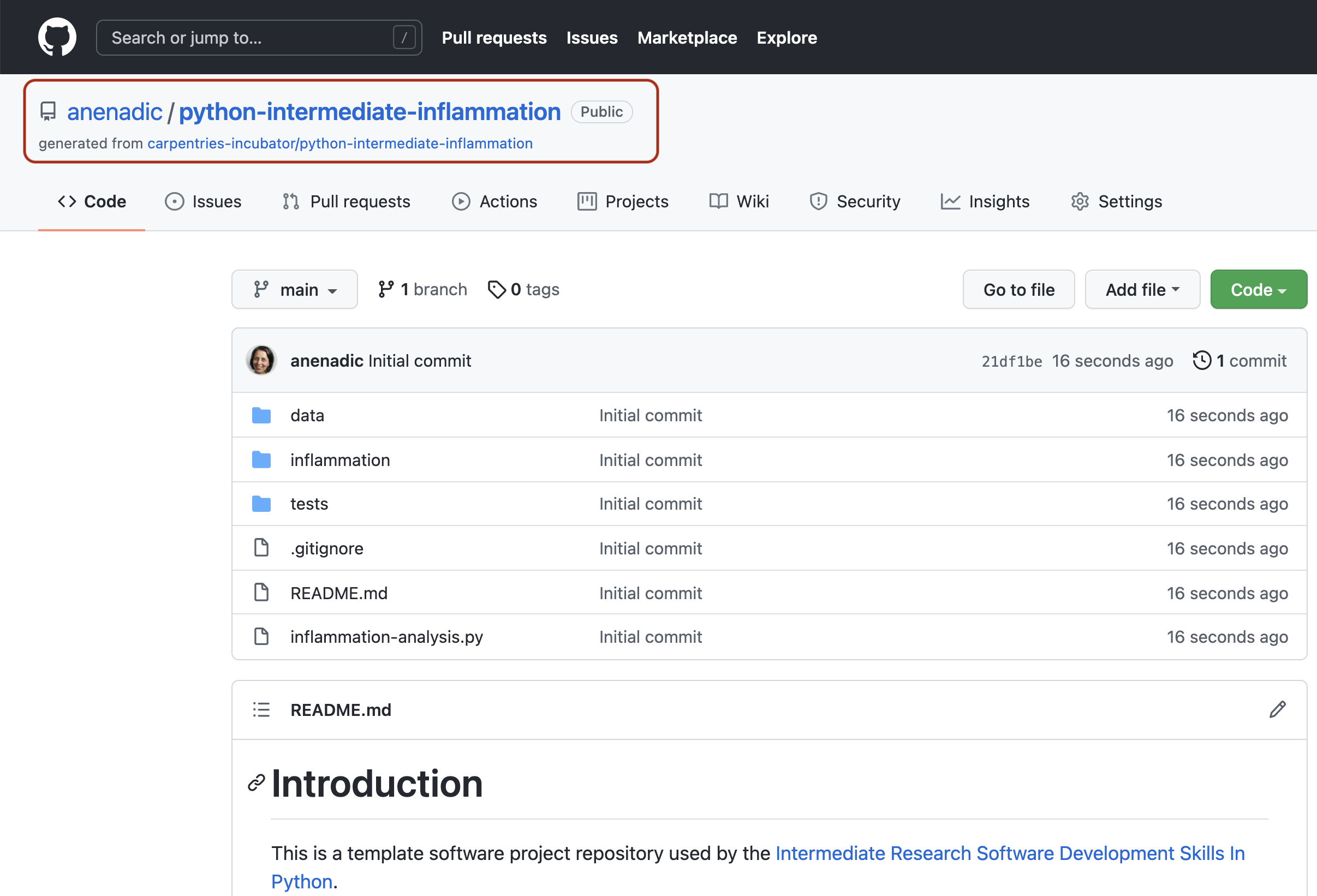
Exercise: Obtain the Software Project Locally
Using the command line, clone the copied repository from your GitHub account into the home directory on your computer. Which command(s) would you use to get a detailed list of contents of the directory you have just cloned?
Solution
- Find the URL of the software project repository to clone from your GitHub account. Make sure you do not clone the original template repository but rather your own copy, as you should be able to push commits to it later on. Make sure you use the HTTPS link, and not the SSH one.
- Make sure you are located in your home directory in the command line with:
$ cd ~- From your home directory in the command line, do:
$ git clone https://github.com:<YOUR_GITHUB_USERNAME>/python-intermediate-inflammation.gitMake sure you are cloning your copy of the software project and not the template repository.
- Navigate into the cloned repository folder in your command line with:
$ cd python-intermediate-inflammation
Our Software Project Structure
Let’s inspect the content of the software project from the command line. From the root directory of the project, you can
use the command ls -l to get a more detailed list of the contents. You should see something similar to the following.
$ cd ~/python-intermediate-inflammation
$ ls -l
total 24
-rw-r--r-- 1 carpentry users 1055 20 Apr 15:41 README.md
drwxr-xr-x 18 carpentry users 576 20 Apr 15:41 data
drwxr-xr-x 5 carpentry users 160 20 Apr 15:41 inflammation
-rw-r--r-- 1 carpentry users 1122 20 Apr 15:41 inflammation-analysis.py
drwxr-xr-x 4 carpentry users 128 20 Apr 15:41 tests
As can be seen from the above, our software project contains the README file (that typically describes the project,
its usage, installation, authors and how to contribute), Python script inflammation-analysis.py,
and three directories - inflammation, data and tests.
The Python script inflammation-analysis.py provides the main
entry point in the application, and on closer inspection, we can see that the inflammation directory contains two more Python scripts -
views.py and models.py. We will have a more detailed look into these shortly.
$ ls -l inflammation
total 24
-rw-r--r-- 1 alex staff 71 29 Jun 09:59 __init__.py
-rw-r--r-- 1 alex staff 838 29 Jun 09:59 models.py
-rw-r--r-- 1 alex staff 649 25 Jun 13:13 views.py
Directory data contains several files with patients’ daily inflammation information (along with some other files):
$ ls -l data
total 264
-rw-r--r-- 1 alex staff 5365 25 Jun 13:13 inflammation-01.csv
-rw-r--r-- 1 alex staff 5314 25 Jun 13:13 inflammation-02.csv
-rw-r--r-- 1 alex staff 5127 25 Jun 13:13 inflammation-03.csv
-rw-r--r-- 1 alex staff 5367 25 Jun 13:13 inflammation-04.csv
-rw-r--r-- 1 alex staff 5345 25 Jun 13:13 inflammation-05.csv
-rw-r--r-- 1 alex staff 5330 25 Jun 13:13 inflammation-06.csv
-rw-r--r-- 1 alex staff 5342 25 Jun 13:13 inflammation-07.csv
-rw-r--r-- 1 alex staff 5127 25 Jun 13:13 inflammation-08.csv
-rw-r--r-- 1 alex staff 5327 25 Jun 13:13 inflammation-09.csv
-rw-r--r-- 1 alex staff 5342 25 Jun 13:13 inflammation-10.csv
-rw-r--r-- 1 alex staff 5127 25 Jun 13:13 inflammation-11.csv
-rw-r--r-- 1 alex staff 5340 25 Jun 13:13 inflammation-12.csv
-rw-r--r-- 1 alex staff 22554 25 Jun 13:13 python-novice-inflammation-data.zip
-rw-r--r-- 1 alex staff 12 25 Jun 13:13 small-01.csv
-rw-r--r-- 1 alex staff 15 25 Jun 13:13 small-02.csv
-rw-r--r-- 1 alex staff 12 25 Jun 13:13 small-03.csv
As previously mentioned, each of the inflammation data files contains separate trial data for 60 patients over 40 days.
Exercise: Have a Peek at the Data
Which command(s) would you use to list the contents or a first few lines of
data/inflammation-01.csvfile?Solution
- To list the entire content of a file from the project root do:
cat data/inflammation-01.csv.- To list the first 5 lines of a file from the project root do:
head -n 5 data/inflammation-01.csv.0,0,1,3,2,3,6,4,5,7,2,4,11,11,3,8,8,16,5,13,16,5,8,8,6,9,10,10,9,3,3,5,3,5,4,5,3,3,0,1 0,1,1,2,2,5,1,7,4,2,5,5,4,6,6,4,16,11,14,16,14,14,8,17,4,14,13,7,6,3,7,7,5,6,3,4,2,2,1,1 0,1,1,1,4,1,6,4,6,3,6,5,6,4,14,13,13,9,12,19,9,10,15,10,9,10,10,7,5,6,8,6,6,4,3,5,2,1,1,1 0,0,0,1,4,5,6,3,8,7,9,10,8,6,5,12,15,5,10,5,8,13,18,17,14,9,13,4,10,11,10,8,8,6,5,5,2,0,2,0 0,0,1,0,3,2,5,4,8,2,9,3,3,10,12,9,14,11,13,8,6,18,11,9,13,11,8,5,5,2,8,5,3,5,4,1,3,1,1,0
Directory tests contains several tests that have been implemented already. We will be adding more tests
during the course as our code grows.
An important thing to note here is that the structure of the project is not arbitrary. One of the big differences between novice and intermediate software development is planning the structure of your code. This structure includes software components and behavioural interactions between them (including how these components are laid out in a directory and file structure). A novice will often make up the structure of their code as they go along. However, for more advanced software development, we need to plan this structure - called a software architecture - beforehand.
Let’s have a more detailed look into what a software architecture is and which architecture is used by our software project before we start adding more code to it.
Software Architecture
A software architecture is the fundamental structure of a software system that is decided at the beginning of project development based on its requirements and cannot be changed that easily once implemented. It refers to a “bigger picture” of a software system that describes high-level components (modules) of the system and how they interact.
In software design and development, large systems or programs are often decomposed into a set of smaller
modules each with a subset of functionality. Typical examples of modules in programming are software libraries;
some software libraries, such as numpy and matplotlib in Python, are bigger modules that contain several
smaller sub-modules. Another example of modules are classes in object-oriented programming languages.
Programming Modules and Interfaces
Although modules are self-contained and independent elements to a large extent (they can depend on other modules), there are well-defined ways of how they interact with one another. These rules of interaction are called programming interfaces - they define how other modules (clients) can use a particular module. Typically, an interface to a module includes rules on how a module can take input from and how it gives output back to its clients. A client can be a human, in which case we also call these user interfaces. Even smaller functional units such as functions/methods have clearly defined interfaces - a function/method’s definition (also known as a signature) states what parameters it can take as input and what it returns as an output.
There are various software architectures around defining different ways of dividing the code into smaller modules with well defined roles, for example:
- Model–View–Controller (MVC) architecture, which we will look into in detail and use for our software project,
- Service-oriented architecture (SOA), which separates code into distinct services, accessible over a network by consumers (users or other services) that communicate with each other by passing data in a well-defined, shared format (protocol),
- Client-server architecture, where clients request content or service from a server, initiating communication sessions with servers, which await incoming requests (e.g. email, network printing, the Internet),
- Multilayer architecture, is a type of architecture in which presentation, application processing and data management functions are split into distinct layers and may even be physically separated to run on separate machines - some more detail on this later in the course.
Model-View-Controller (MVC) Architecture
MVC architecture divides the related program logic into three interconnected modules:
- Model (data)
- View (client interface), and
- Controller (processes that handle input/output and manipulate the data).
Model represents the data used by a program and also contains operations/rules for manipulating and changing the data in the model. This may be a database, a file, a single data object or a series of objects - for example a table representing patients’ data.
View is the means of displaying data to users/clients within an application (i.e. provides visualisation of the state of the model). For example, displaying a window with input fields and buttons (Graphical User Interface, GUI) or textual options within a command line (Command Line Interface, CLI) are examples of Views. They include anything that the user can see from the application. While building GUIs is not the topic of this course, we will cover building CLIs in Python in later episodes.
Controller manipulates both the Model and the View. It accepts input from the View and performs the corresponding action on the Model (changing the state of the model) and then updates the View accordingly. For example, on user request, Controller updates a picture on a user’s GitHub profile and then modifies the View by displaying the updated profile back to the user.
MVC Examples
MVC architecture can be applied in scientific applications in the following manner. Model comprises those parts of the application that deal with some type of scientific processing or manipulation of the data, e.g. numerical algorithm, simulation, DNA. View is a visualisation, or format, of the output, e.g. graphical plot, diagram, chart, data table, file. Controller is the part that ties the scientific processing and output parts together, mediating input and passing it to the model or view, e.g. command line options, mouse clicks, input files. For example, the diagram below depicts the use of MVC architecture for the DNA Guide Graphical User Interface application.
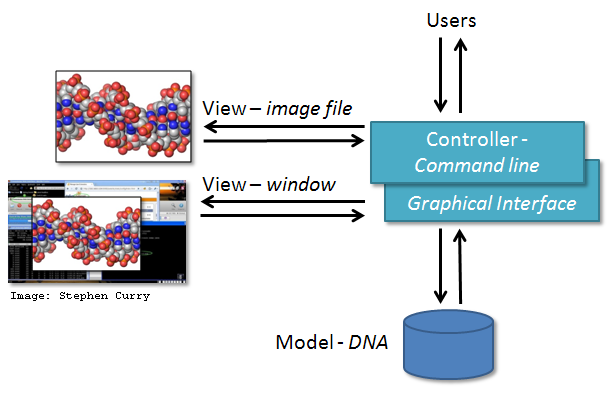
Exercise: MVC Application Examples From your Work
Think of some other examples from your work or life where MVC architecture may be suitable or have a discussion with your fellow learners.
Solution
MVC architecture is a popular choice when designing web and mobile applications. Users interact with a web/mobile application by sending various requests to it. Forms to collect users inputs/requests together with the info returned and displayed to the user as a result represent the View. Requests are processed by the Controller, which interacts with the Model to retrieve or update the underlying data. For example, a user may request to view its profile. The Controller retrieves the account information for the user from the Model and passes it to the View for rendering. The user may further interact with the application by asking it to update its personal information. Controller verifies the correctness of the information (e.g. the password satisfies certain criteria, postal address and phone number are in the correct format, etc.) and passes it to the Model for permanent storage. The View is then updated accordingly and the user sees its updated profile details.
Note that not everything fits into the MVC architecture but it is still good to think about how things could be split into smaller units. For a few more examples, have a look at this short article on MVC from CodeAcademy.
Separation of Concerns
Separation of concerns is important when designing software architectures in order to reduce the code’s complexity. Note, however, there are limits to everything - and MVC architecture is no exception. Controller often transcends into Model and View and a clear separation is sometimes difficult to maintain. For example, the Command Line Interface provides both the View (what user sees and how they interact with the command line) and the Controller (invoking of a command) aspects of a CLI application. In Web applications, Controller often manipulates the data (received from the Model) before displaying it to the user or passing it from the user to the Model.
Our Project’s MVC Architecture
Our software project uses the MVC architecture. The file inflammation-analysis.py is the Controller module that
performs basic statistical analysis over patient data and provides the main
entry point into the application. The View and Model modules are contained
in the files views.py and models.py, respectively, and are conveniently named. Data underlying the Model is
contained within the directory data - as we have seen already it contains several files with patients’ daily inflammation information.
We will revisit the software architecture and MVC topics once again in later episodes when we talk in more detail about software’s business/user/solution requirements and software design. We now proceed to set up our virtual development environment and start working with the code using a more convenient graphical tool - IDE PyCharm.
Key Points
Programming interfaces define how individual modules within a software application interact among themselves or how the application itself interacts with its users.
MVC is a software design architecture which divides the application into three interconnected modules: Model (data), View (user interface), and Controller (input/output and data manipulation).
The software project we use throughout this course is an example of an MVC application that manipulates patients’ inflammation data and performs basic statistical analysis using Python.